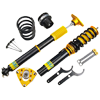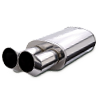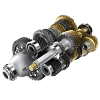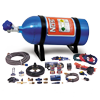In 1998, Toyota started offering a new technology, VVTL-i, which can
alter valve lift (and duration) as well as valve timing. In the case
of the 16 valve 2ZZ-GE, the engine has 2 camshafts, one operating
intake valves and one operating exhaust valves. Each camshaft has
two lobes per cylinder, one low rpm lobe and one high rpm, high lift,
long duration lobe. Each cylinder has two intake valves and two exhaust valves.
Each set of two valves are controlled by one rocker arm, which is
operated by the camshaft. Each rocker arm has a slipper follower
mounted to the rocker arm with a spring, allowing the slipper follower
to move up and down with the high lobe with out affecting the rocker
arm. When the engine is operating below 6000 rpm, the low lobe is
operating the rocker arm and thus the valves. When the engine is
operating above 6000 rpm, the ECU activates an oil pressure switch
which pushes a sliding pin under the slipper follower on each rocker
arm. This in effect, switches to the high lobe causing high lift and
longer duration.




























